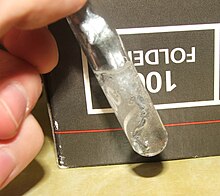**1. Acid Definitions and Concepts:**
– Modern definitions focus on fundamental chemical reactions common to all acids.
– Arrhenius and Brønsted–Lowry definitions are relevant for most acids in daily life.
– Brønsted–Lowry definition involves proton transfer from an acid to a base.
– Hydronium ions are acidic according to all three definitions.
– Alcohols and amines can act as Brønsted–Lowry acids but also as Lewis bases.
**2. Types of Acids and Their Characteristics:**
– Arrhenius acids increase H ions in water, forming hydronium ions.
– Brønsted acids donate protons to bases in acid–base reactions.
– Lewis acids accept electron pairs from other species.
– Acid strength refers to the ability to lose a proton, with strong acids completely dissociating in water.
– Monoprotic and polyprotic acids can donate different numbers of protons per molecule.
**3. Acid Reactions and Equilibrium:**
– Reactions of acids are often represented by HA⇌H + A, involving protolysis.
– Acid reactions at 25°C in aqueous solution are commonly referenced.
– Weak acid–weak base equilibrium involves proton transfers and pH shifts.
– Titration is used to determine acid concentration and involves neutralizing with a strong base.
**4. Applications and Uses of Acids:**
– Acids are crucial in modern industry processes like fertilizer and detergent production.
– Acids are used in metal pickling, battery electrolytes, and ester production.
– Acids play biological roles in DNA, RNA, proteins, and enzyme catalysis.
– Acids are essential in various industrial processes and the food industry.
**5. Safety and Handling of Acids:**
– Safety precautions when handling acids include wearing appropriate PPE and storing them away from bases.
– Acids should be used in well-ventilated areas to prevent fume inhalation.
– In case of spills, acids should be neutralized with a base, and containers should be properly labeled.
– Proper handling and safety measures are essential when dealing with acids to prevent accidents and exposure risks.
An acid is a molecule or ion capable of either donating a proton (i.e. hydrogen ion, H+), known as a Brønsted–Lowry acid, or forming a covalent bond with an electron pair, known as a Lewis acid.

The first category of acids are the proton donors, or Brønsted–Lowry acids. In the special case of aqueous solutions, proton donors form the hydronium ion H3O+ and are known as Arrhenius acids. Brønsted and Lowry generalized the Arrhenius theory to include non-aqueous solvents. A Brønsted or Arrhenius acid usually contains a hydrogen atom bonded to a chemical structure that is still energetically favorable after loss of H+.
Aqueous Arrhenius acids have characteristic properties that provide a practical description of an acid. Acids form aqueous solutions with a sour taste, can turn blue litmus red, and react with bases and certain metals (like calcium) to form salts. The word acid is derived from the Latin acidus, meaning 'sour'. An aqueous solution of an acid has a pH less than 7 and is colloquially also referred to as "acid" (as in "dissolved in acid"), while the strict definition refers only to the solute. A lower pH means a higher acidity, and thus a higher concentration of positive hydrogen ions in the solution. Chemicals or substances having the property of an acid are said to be acidic.
Common aqueous acids include hydrochloric acid (a solution of hydrogen chloride that is found in gastric acid in the stomach and activates digestive enzymes), acetic acid (vinegar is a dilute aqueous solution of this liquid), sulfuric acid (used in car batteries), and citric acid (found in citrus fruits). As these examples show, acids (in the colloquial sense) can be solutions or pure substances, and can be derived from acids (in the strict sense) that are solids, liquids, or gases. Strong acids and some concentrated weak acids are corrosive, but there are exceptions such as carboranes and boric acid.
The second category of acids are Lewis acids, which form a covalent bond with an electron pair. An example is boron trifluoride (BF3), whose boron atom has a vacant orbital that can form a covalent bond by sharing a lone pair of electrons on an atom in a base, for example the nitrogen atom in ammonia (NH3). Lewis considered this as a generalization of the Brønsted definition, so that an acid is a chemical species that accepts electron pairs either directly or by releasing protons (H+) into the solution, which then accept electron pairs. Hydrogen chloride, acetic acid, and most other Brønsted–Lowry acids cannot form a covalent bond with an electron pair, however, and are therefore not Lewis acids. Conversely, many Lewis acids are not Arrhenius or Brønsted–Lowry acids. In modern terminology, an acid is implicitly a Brønsted acid and not a Lewis acid, since chemists almost always refer to a Lewis acid explicitly as a Lewis acid.
